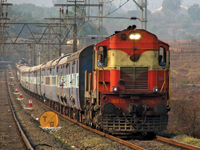
FOREIGN tourists visiting India have often voice their frustration over the country's inadequate infrastructure, antiquated airports and railways, absence of proper roads, and the outrageous room prices which hotels impose because of shortages in the country.
However, Indian Tourism Minister Subodh Kant Sahai told TTN that the Tourism Ministry was pressing ahead with plans to develop “quality tourism infrastructure” across the country.
“The ministry provides financial assistance to state governments for tourism projects identified in consultation with them for improvement of existing tourism products and also developing new ones,” he said. “We even provide 100 per cent central assistance under a scheme to develop destinations or circuits to world standards as well as for rural infrastructure development.”
The projects being currently implemented are a judicious mix of culture, heritage, spiritual and eco-tourism while the rural infrastructure is also being developed with the aim of ensuring that socio-economic benefits percolate down to the community.
The ministry is executing these projects in co-ordination with the railway, aviation, and roads and transport ministries to achieve greater synergies and secure the best returns from these investments, he said.
Tourism currently contributes some six per cent to India’s gross domestic product (GDP) and tourism traffic has been growing at 9-10 per cent, but India is trying to achieve a 12 per cent growth rate, he said.
“India’s five year plan has accorded priority to tourism infrastructure development and we are giving priority to the hotel industry, particularly the establishment of budget hotels,” he said.
Another focal point is the expansion and modernisation of its transport industry, with as many as 50 airports expected to be upgraded or established. By the end of 2012, Kolkata and Chennai airports would be completely comdernised, while substantial investments would also be made in modern ports for luxury cruises.
“The government is keen to attract foreign investments in tourism. We are focusing on the development of roads, and railways to improve connectivity and facilitate travel. This will be particularly helpful while developing religious-related tourism for Buddhist, Jain, Hindu, Sikh, Christian and Sufi destinations,” he said.
Foreign investors are often put off by the central government’s inability to implement projects in various states, but Sahai says his ministry is now asking all the states to “take action in alignment with the federal policy”.
“We would like to attract foreign investments in the hotel industry, service apartments, adventure tourism, health tourism, convention centres, wildlife tourism, highways and amusement parks,” he said.
There have also been multilateral projects for developing tourism-specific infrastructure.
The Asian Development Bank and the states of Tamil Nadu and Uttarakhand recently signed a $43.84-million loan agreement under a second tranche of an infrastructure development investment programme for tourism.
The programme had been approved in 2010 for a total loan package of $250 million under a multi-tranche financing facility to assist in developing tourism-related infrastructure in the four states of Himachal Pradesh, Punjab, Uttarakhand and Tamil Nadu.
Projects under the first tranche worth $43.42 million are already under way in Punjab and Himachal Pradesh.
The second tranche envisages the construction and modernisation of urban infrastructure and connectivity relative to tourist attractions in Uttarakhand and Tamil Nadu.
The programme’s objective is to promote sustainable development of tourism with a provision of levying appropriate fees or user charges to pursue cost recovery.
Though the World Economic Forum sees India as a promising Asia-Pacific destination, India’s tourism traffic is much lower compared to other destinations in the region.
However, many experts believe that its tourism potential remains untapped.
Also, there is an urgent need to build more hotels for the leisure tourist, they say. The outrageous prices of rooms in five-star hotels –which are patronised mainly by business travellers whose tabs are picked up by their companies – are keeping leisure tourists away and India needs to provide affordable rooms for these tourists who find the prices of hotels in other Asian destinations such as Thailand, Indonesia and Malaysia comparatively much lower than in India.
Personal safety is another issue that needs to be addressed. Women, in particular, feel unsafe in places such as Rajasthan, Goa and even Delhi where incidents of molestation of women and robberies of foreign tourists have been reported. But Sahai says his ministry is aware and ready to act on these problems. “We are working closely with the police to deal swiftly with such incidents,” he said, adding that his ministry would also try to enforce a ‘cleanliness programme’ at 50 destinations in the country to eradicate squalor and “make foreign tourists feel welcome”.
By Manik Mehta
